Removal
|
In case of removing the high pressure fuel pump, high pressure fuel pipe, delivery pipe, and injector, there may be injury caused by leakage of the high pressure fuel. So don’t do any repair work right after engine stops.
|
| 1. |
Turn the ignition switch OFF and disconnect the battery negative (-) cable.
|
| 2. |
Release the residual pressure in fuel line (Refer to the Fuel Delivery System - Repair Procedures - "Release Residual Pressure in Fuel Line").
|
When removing the fuel pump fuse, a Diagnostic Trouble Code (DTC) may occur.
Delete the code with the GDS after completion of “Release Residual Pressure in Fuel Line” work.
|
|
| 3. |
Remove the high pressure fuel pump form
|
| 4. |
Disconnect the fuel pressure control valve connector (A).
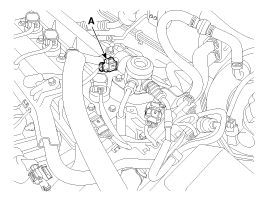
|
| 5. |
Open the low pressure fuel tube clip (A).
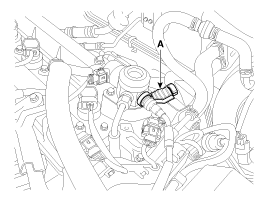
|
| 6. |
Release the low pressure fuel quick-connector (A) using the clip remover (B).
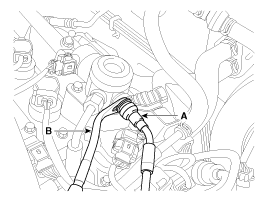
|
When removing the low pressure fuel quick-connector, use a clip remover as shown in the image below.
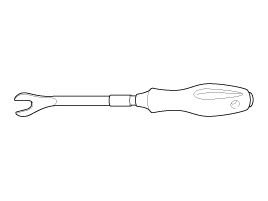
|
|
| 7. |
Remove the high pressure fuel pipe.
(Refer to Fuel Delivery System - "Fuel Line - High pressure fuel line")
|
| 8. |
Remove the installation bolts (A), and then remove the high pressure fuel pump from the cylinder head assembly.
|
Unscrew in turn the two bolts in small step (0.5 turns). In case of fully unscrewing one of the two bolts with the other bolt installed, the housing surface of the cylinder head may be broken because of tension of the pump spring.
|
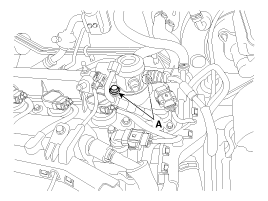
|
Installation
| • |
Be sure to check the low pressure fuel hose quick-connector (A) is completely connected to the high pressure fuel pump until a confirmation 'click' sound is heard.
|
| • |
Be sure to re-check the low pressure fuel hose is completely connected to the high pressure fuel pump by pulling it after connecting.
|
| • |
Be sure to install the high pressure fuel pipe (B) with the specified torques.
|
| • |
Because fuel leak may cause fire, securely Inspect leakage of all fuel line connection parts at engine start condition.
|
|
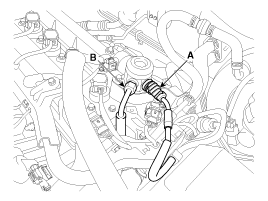
| • |
Before installing the high pressure fuel pump, position the roller tappet in the lowest position by rotating the crankshaft. Otherwise the installation bolts may be broken because of tension of the pump spring.
|
|
| • |
Do not reuse the used bolt.
|
|
| • |
Do not reuse the used high pressure fuel pipe.
|
|
| • |
When tightening the installation bolts of the high pressure fuel pump, tighten in turn the bolts in small step (0.5 turns) after tightening them with hand-screwed torque.
|
|
| • |
Install the component with the specified torques.
|
| • |
First hand-tighten the fasteners fully until they are not fastened any more in order to have them inserted in place and then completely tighten to the specified torque using a torque wrench.
If not tightening the bolts or nuts in a straight line with the mating bolt holes or fittings, it may cause a fuel leak due to broken threads.
|
|
| • |
Note that internal damage may occur when the component is dropped. In this case, use it after inspecting.
|
|
| • |
Apply engine oil to the O-ring (A) of the high pressure fuel pump, the roller tappet (B), and the protrusion (C). Also apply engine oil to the groove on the location where the protrusion (C) is installed.
|
|
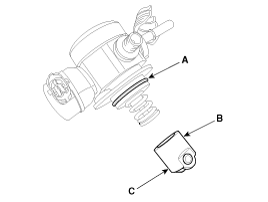
| 1. |
Install in the reverse order of removal.
|
Use the special service tool [SST No.: 09314-3Q100 or 09314-27130] to install the high pressure fuel pipe.
|
|
High pressure fuel pump mounting bolt: 12.8 ~ 14.7 N.m (1.3 ~ 1.5 kgf.m, 9.4 ~ 10.9 lb-ft)
High pressure fuel pipe flang nut: 26.5 ~ 32.4 N.m (2.7 ~ 3.3 kgf.m, 19.5 ~ 23.9 lb-ft)
High pressure fuel pipe function block mounting bolt: 9.8 ~ 11.8 N.m (1.0 ~ 1.2 kgf.m, 7.2 ~ 8.7 lb-ft)
|
|
See also:
Under Body
Projected Dimensions
* These dimensions indicated in this figure are actual-measurement
dimensions. [ Unit : mm (inch) ]
Actual-Measurement Dimensions
* These d ...
Tightening Torques
Items
N.m
kgf.m
lb-ft
Compressor
20.0 ~ 32.95
2.04 ~ 3.36
14.75 ~ 24.30
Condenser - Discharge hose
4.9 ~ 7.8
0. ...
Climate control air filter Cleaning
1.
Remove the climate control air filter.
2.
Check that the climate control air filter is not excessively dirty.
...
 Kia Soul: High Pressure Fuel Pump. Repair procedures
Kia Soul: High Pressure Fuel Pump. Repair procedures

 Delivery Pipe. Repair procedures
Delivery Pipe. Repair procedures Clutch System
Clutch System






